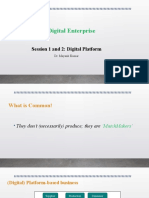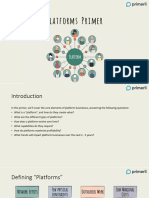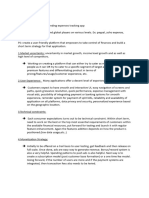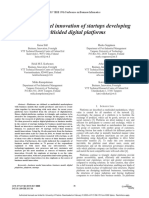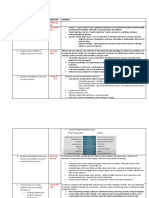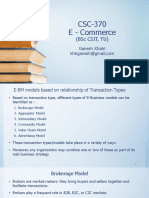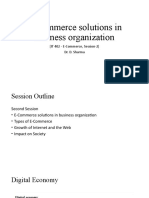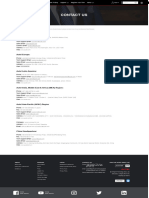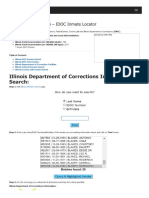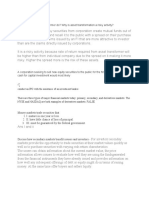0 ratings0% found this document useful (0 votes)
12 views3 pagesFinals CheatSheet
The document discusses various principles of monetization and the time value of money, emphasizing the importance of interaction conversion rates and network effects in platform business models. It outlines methods for calculating present value, future cash flows, and customer lifetime value, while also highlighting the significance of metrics during different phases of platform maturity. Additionally, it covers marketing evolution, customer relationship management, and pricing strategies, including price discrimination and bundled pricing.
Uploaded by
Joey GohCopyright
© © All Rights Reserved
We take content rights seriously. If you suspect this is your content, claim it here.
Available Formats
Download as DOCX, PDF, TXT or read online on Scribd
0 ratings0% found this document useful (0 votes)
12 views3 pagesFinals CheatSheet
The document discusses various principles of monetization and the time value of money, emphasizing the importance of interaction conversion rates and network effects in platform business models. It outlines methods for calculating present value, future cash flows, and customer lifetime value, while also highlighting the significance of metrics during different phases of platform maturity. Additionally, it covers marketing evolution, customer relationship management, and pricing strategies, including price discrimination and bundled pricing.
Uploaded by
Joey GohCopyright
© © All Rights Reserved
We take content rights seriously. If you suspect this is your content, claim it here.
Available Formats
Download as DOCX, PDF, TXT or read online on Scribd
You are on page 1/ 3
TIME VALUE OF MONEY *shifted from broadcast to segmentation, virality and social Monetisation principles to Abide By Interaction conversion
isation principles to Abide By Interaction conversion rate remains important
influence 1. Avoid charging for value that users previously received for Side switching, important metric and to maintain balance
*shifted from push to pull free Consumer side
*shifted from outbound to inbound 2. Avoid reducing access to value that users have become o Frequency of consumption, searches, and rate of
Network Effects : the impact that the number of users of a accustomed to receiving conversion to sale
Discounted Cash Flow (DCF): Method of calculating present platform has on the value created for each user 3. Strive to create additional value that justified the charge o Retention and lifetime metrics as in traditional business
value by discounting future cash flows Positive vs Negative: imposed (promoting loyalty and reducing churn – monetary or
Discount Factor (DF): Present value of a $1 future payment +ve: produce significant value for each user 4. Monetisation strategies should be considered when making otherwise)
-ve: reduce value for each user the initial platform design choices Producer side
Two-sided Metrics: Pipeline Model o Frequency of producer participation, listings created and
Can spend money to attract participants to one side of the 1. Produce goods and services efficiently in sufficient numbers outcomes achieved
Discount Rate: Interest rate used to compute present values
market to meet DD (Operations) o Should also monitor interaction failure
of future cash flows
Quite different from price (temporary) and brand (difficult to 2. Reach customers through proper channels at appropriate o Producer fraud (failure of producer to describe product
Perpetuity: A stream of level cash payments that never ends
sustain) effects prices (Marketing) offering accurately or deliver it in a timely fashion)
Virality can attract people but network effects keep people 3. Ensure adequate revenues are generated to produce profits o Retention and lifetime value metrics as in traditional
there and value for investors (Finance) business (repeat producers are profitable, churn rates are
Annuity: Level stream of cash flows at regular intervals with a Most important for firms to be able to scale seamlessly *Includes Cash flow, Inventory turns, Operating income, Gross low)
finite maturity Types margin, Overhead, ROI Metrics During the Maturity Phase
Platform Models Should be able to adapt to the needs of its users and
Platforms generate value through network effect changes in competitive and regulatory environment
PV Annuity Factor (PVAF): The present value of $1 a year Metrics should measure rate of interaction success and the Has to be done with care as otherwise the existing
for each of t years factors that contribute to it ecosystem is scared. Best to incorporate applications that
Focus should be on metrics that quantify the success in are provided by multiple providers.
generating desirable interactions among participants Can also incorporate a feature if a third-part feature
Future Value of Annuity Payment Metrics During the Startup Phase provides a large share of value enjoyed by the users
Tracks growth of active producers and consumers who are General Guidelines for Metrics – should measure the
participating in a large volume of successful interactions number of happy customers on every side of the network who
Annuity Due: Level stream of cash flows starting Metric 1: Liquidity are repeated and increasingly engage in positive, value-
immediately o Ensures there exists a minimum number of producers and creating interactions
consumers, and percentage of successful interactions is Actionable: clear guidance for strategic and managerial
high decisions
o Tracks the percentage of listing that lead to interactions Accessible: comprehensible to people who gather and use
within a given time period the information
Positive same-side
Effective Annual Interest Rate: Interest rate that is o Illiquid situations must be minimised Auditable: real and meaningful based on clean, accurate
o Positive benefits received by users when t he number of
annualized using compound interest o Focus on active usage rather than number of sign ups data and precisely defined reflecting the reality of business
users of the same kind increases
o Ratio and comparative metrics are best as perceived by the users
Negative same-side
Metric 2: Matching Quality The Future of Platform Revolutions
o Effect of competition
Annual Percentage Rate: Interest rate that is annualized o Refers to accuracy of search algorithm and depends on Businesses that are like to join
Positive cross-side effects
using simple interest curation o Information intensive
o Users benefitting from an increasing number of
*MR = monthly interest rate o Measures the percentage of searches leading to o Non-scalable gate-keepers
participants on the other side of the market
interactions (sales conversion rate) o Highly fragmented industries
o E.g. Visa, Mastercard, increase convenience
Inflation: Rate at which prices as a whole are increasing o Measures the correlation between interaction rate and o Extreme information asymmetries
Nominal Interest Rate: Rate at which money invested grows Negative cross-side effects
long-term rate of activity of users to come up with a Industries that can resist disruption
Real Interest Rate: Rate at which the purchasing power of an o Matching problems and clutter
threshold – can be a measure of the platform o High regulatory control
investment increases o E.g. Uber, too many drivers to riders, higher driver down
Metric 3: Trust o High failure costs
time
o Degree to which users are comfortable with risks o Resource intensive
Monetisation
associated with engaging in interactions on the platform MARKETING
Charging a transaction fee
o Excellent curation helps Evolution of Marketing
o Only transaction charged, not discouraged from joining
o Critical in platforms where people may interact with each 1. IR (19th Century): Production
*Current dollar cash flows must be discounted by the nominal o Should experience with various levels to get fair
other for the first time online 2. Early 20th Century: Product & Finance
interest rate percentage o f value without driving users away
o One way is to review each other 3. 1930s: Sales
*Real cash flows must be discounted by the real interest rate o Problem: may take activity outside platform
Range of metrics measuring commitment to ecosystem 4. 1960s: Marketing
PLATFORM BUSINESS MODELS Charging for access
- time between interactions 5. Early 21st Century: Digital & Social (Platforms)
Linear Value Chain (Traditional System) o Charge producers to access community of users, doesn’t
- percentage of active users Production Concept
discourage
Outcome based metrics Focus on production and distribution efficiency
Charging for enhanced access
- Number of nights booked Assumes consumers prefer products that are available and
Platform Structure o Important to ensure customers can distinguish between
- Number of work hours highly affordable
Can act as both consumer and producer content that has been elevated by paid access
Content creation metrics Appropriate when DD > SS, improved productivity
Connect and conduct interactions with one another using o Important to limit sponsored posts so that the platform
- Consumer relevance (listings receiving +ve response decreases high costs
resources provided by the platform still relevant, rather than cluttered
from potential customers) Impersonal, insensitive, assembly-line orientation
Exchange, consume and co-create something of value o Charge users for lowering barriers
- Co-creation (listings that received some minimum level Product Concept
Charging for enhanced curation positive response from potential consumers) Focus on making continued product innovation
o Improve quality of interactions, enhanced vetting and Market access regardless of complete interaction Assumes consumers prefer products with the highest
screening - Restaurant reservations quality, best features and performance
Advantages of Platforms
o Transaction to subscription - Number of women registered in dating sites Leads to marketing myopia
No gatekeepers to manage flow (replaced by
Whom to Charge? Metrics During the Growth Phase Selling Concept
market flow)
All users (rare, used at vetting process) To ensure platform is still growing (startup metrics are Concentrate on selling and promotion
New sources of value and supply (sharing
Charging one side, subsidizing the other insufficient) Assumes consumers will not buy enough unless stimulated
economy)
Charging users full price while subsidizing stars Balance between two sides must be maintained (producer: aggressively
Community feedback loops
Price discrimination based on price sensitivity consumer)
Normally used for unsought good o Market segmentation, targeting & positioning Customer Centric Business Models Price Elasticity of Demand (Elastic vs Inelastic DD,
“Hard Sell”, unscrupulous image Segmentation: Dividing a market into smaller Determine most valuable customers Cross-elasticity – substitutes & complements)
Marketing Concept groups with distinct needs, characteristics, or Maximise long term value – not necessarily the additional o Consumer perceptions
Determine the needs and wants of target markets and behaviours who might require separate products margin of their current purchase Price-quality relationship
delivering them more effectively and efficiently than or marketing mixes. A market segment consists of Build relationships and look at the future Price used in absence of other cues
competitors consumers who respond in a similar way to a given Customer acquisition, customer retention, customer o Competition
Create, build and maintain beneficial exchanges with target set of marketing efforts development Reference point
buyers to achieve organizational objects Targeting: The process of evaluating each market Customer Lifetime Value (CLV): The dollar value of a Responsiveness
Focus on buyers’ needs vs sellers’ needs segment’s attractiveness and selecting one or customer relationship, net present value of all future cash Product homogeneity (more price sensitive)
Recognise needs not just product based more segments to enter flows from a customer relationship o Other environmental factors (economy, resellers, govt)
Stress regular consumer research and analysis Positioning perception based Computed using past data about a customer to predict the Economic conditions
Resources allocated to make goods and services desired by a. Differentiation: Actually differentiating the future Distributor reactions
consumers market offering to create superior customer Useful in determining how much to spend on customer Government
Customer Driven vs Customer Driving value acquisition and retention Methods and Strategies
b. Positioning: Arranging for a product to Current Value of Future Cash Flows New Product Pricing
occupy a clear, distinctive, and desirable Price Skimming
place relative to competing products in the o Sets a high price for a new product to “skim” revenues
minds of target consumers CLV Model layer by layer from the market
Develop Marketing Mix (4P’s) o Fewer, but more profitable sales
o When to use:
M: margin R: retention spending r: retention rate Segmentation on price elasticity
D: discount rate Survival rate: t = rt – 1 Image supportive
CLV Extensions Safety/Hedge
Duration: Infinity or a few periods? Depends on R and r Costs of smaller volume cannot be so high to
o Low R, high r: much of CLV achieved in first few periods cancel advantage of charging more
Customer Relationship Management (CRM) o High R, low r: little of CLV achieved in first few periods No immediate competition
The process of building and maintaining profitable customer Revenue is obtained after service is delivered Price Penetration
relationships by delivering superior customer value and o Sets a low initial price to “penetrate” the market
satisfaction quickly and deeply
Not everyone is a desirable customer Retention rate increases over time. Thus, it is important to o Can attract a large number of buyers quickly and win
Attract, keep and grow profitable customers calculate CLV among customers of the same cohort. a large market share
Customer Relationship Groups For businesses without formal subscription, other methods o When to use:
Managing the Marketing effort need to be used to evaluate the retention rate, and then Consumers are price sensitive
o Analysis (SWOT) calculate CLV Experience curve effects operative
o Planning (Setting objectives and strategy) CLV and Managerial Decisions Potential competition
o Implementation (Process of turning marketing Targeting of market segment Cost Oriented Pricing
strategies into marketing actions) Marketing expenditures for a particular customer Most common approach
o Control (Evaluating results and taking corrective Fire customers with negative CLV Markup Pricing based on Cost
actions) Customer acquisition: < CLV Predetermined percentage added to product cost
Takeaways Customer retention: < difference in CLV Simple and easy to use
Margin expansion: up-selling, cross-selling and cost cutting Equitable for buyer and seller
resulting in high enough clv to cover costs of investments Focuses on cost to neglect of demand
PRICING Variation – Market based on sales
Factors Influencing Price Target Return or Target Profit Pricing
Economic Approach (DD/SS) Predetermined return on capital used to produce & market
Accounting/Finance Approach (Cost of Capital = Cost * product
Margin) Target return based on standard volume
The Marketing Process Marketing Approach (4Ps)
CUSTOMER LIFETIME VALUE Factors Affecting Price
Delivering Customer Value Internal Factor set by organisation
o Marketing objectives
P: price DVC: direct variable cost
Survival FC: fixed cost X: standard volume
Current profit maximization K: capital used r: desired rate of return
Market share leadership Demand Oriented Pricing
Product quality leadership Methods based on and used to affect consumer
Competitive entry barriers perception
Reseller support Perceived Value Pricing
Cost recover (non-profit & public firms) Price based on buyer’s perception of value
o Marketing mix strategy costs Soundest approach
Product design o Consistent with marketing concept
Product Centric Business Models Distribution Odd or Psychological Pricing
Great product, and producing the same at scale! Promotion Set prices below even-dollar amounts
KPIs include market share, number of new products etc. Price vs non-price competition Used to connote lower price level through
Marketing Management Process Think about Parallel Importers
Growth engines: new products and new markets rounding down
Analyse & Identify Market Opportunities o Organization for pricing
However Loss-Leader Pricing
o Marketing Research & Information Systems External Factor
o Product life cycles have reduced Set prices on selected products at low levels to
o Marketing Environmental Scanning o Nature of market & demand
o Competition has increased because of the internet and increase sales of others, store traffic, & overall
o Consumer & Business Markets Form of Competition (Pure, Monopolistic,
globalization profits
Research & Select Target Markets Oligopolistic, Monopoly) Optional Product Pricing
o Move from selling products to solutions
o Measuring & forecasting demand
Sell accessory products with main product
Captive-Product Pricing
Products that must be used with main product
Captive product: expensive
Main product: cheap
Bundled Pricing
Several products combined and sold as bundle at
reduced price
Promote sales of products that customers may not
usually buy
Price Discrimination
Time (Peak vs Off-Peak)
Place (ERP: Downtown vs Outskirts)
Customer (Adult vs Child vs Senior Citizens)
You might also like
- Platform Monetization: Presented by - Group 2No ratings yetPlatform Monetization: Presented by - Group 221 pages
- ISB - DT - Required Assignment 3.3 - Vivekanand UmbreNo ratings yetISB - DT - Required Assignment 3.3 - Vivekanand Umbre11 pages
- Business-Model-Canvas-Merit-1023 (Roll-147)No ratings yetBusiness-Model-Canvas-Merit-1023 (Roll-147)2 pages
- Business Model Innovation of Startups Developing Multisided Digital PlatformsNo ratings yetBusiness Model Innovation of Startups Developing Multisided Digital Platforms6 pages
- The Economics & Key Decisions of Platforms: © National University of Singapore. All Rights ReservedNo ratings yetThe Economics & Key Decisions of Platforms: © National University of Singapore. All Rights Reserved35 pages
- Platform Business Model: Unit 5 Questions Book Ref AnswerNo ratings yetPlatform Business Model: Unit 5 Questions Book Ref Answer7 pages
- Management of Information Systems in The Digital AgeNo ratings yetManagement of Information Systems in The Digital Age8 pages
- Chapter2 Lecture3 E Commerce Business ModelNo ratings yetChapter2 Lecture3 E Commerce Business Model21 pages
- Chapter 3 Business Models and StrategiesNo ratings yetChapter 3 Business Models and Strategies2 pages
- Lecture 1-Internet and Business StrategyNo ratings yetLecture 1-Internet and Business Strategy42 pages
- Platform Strategy How To Unlock The Power of Communities and Networks To Grow Your Business Laure Claire No Waiting TimeNo ratings yetPlatform Strategy How To Unlock The Power of Communities and Networks To Grow Your Business Laure Claire No Waiting Time127 pages
- E-Commerce Solutions in Business OrganizationNo ratings yetE-Commerce Solutions in Business Organization50 pages
- Fact vs. Fiction in Oscar Wilde's "The Importance of Being Earnest"No ratings yetFact vs. Fiction in Oscar Wilde's "The Importance of Being Earnest"2 pages
- Kirkpatrick Letter To The House Armed Services CommitteeNo ratings yetKirkpatrick Letter To The House Armed Services Committee2 pages
- Complete The Human Tradition in Colonial Latin America 2nd Edition Kenneth J. Andrien (Editor) PDF For All Chapters100% (10)Complete The Human Tradition in Colonial Latin America 2nd Edition Kenneth J. Andrien (Editor) PDF For All Chapters82 pages
- 10+ Proven Ceo Interview Questions (+answers)No ratings yet10+ Proven Ceo Interview Questions (+answers)6 pages
- English Short Drama (7 Minutes) Title: Doraemon (The Final Episode) CastingNo ratings yetEnglish Short Drama (7 Minutes) Title: Doraemon (The Final Episode) Casting8 pages
- (Ebook PDF) Managing Human Resources 11th Edition by Wayne Cascio Full Chapters InstanlyNo ratings yet(Ebook PDF) Managing Human Resources 11th Edition by Wayne Cascio Full Chapters Instanly147 pages
- The Story of Silk: From Ancient China to Modern TimesNo ratings yetThe Story of Silk: From Ancient China to Modern Times7 pages
- Illinois Inmate Search Department of Corrections Idoc LookupNo ratings yetIllinois Inmate Search Department of Corrections Idoc Lookup12 pages
- Michael - Vince Advanced Language Practice With Key Pages 179 180184 186 1No ratings yetMichael - Vince Advanced Language Practice With Key Pages 179 180184 186 15 pages
- Arts in Healthcare: State of The Field ReportNo ratings yetArts in Healthcare: State of The Field Report33 pages

